Consent Audit and Logging: Best Practices & Tools for Compliance
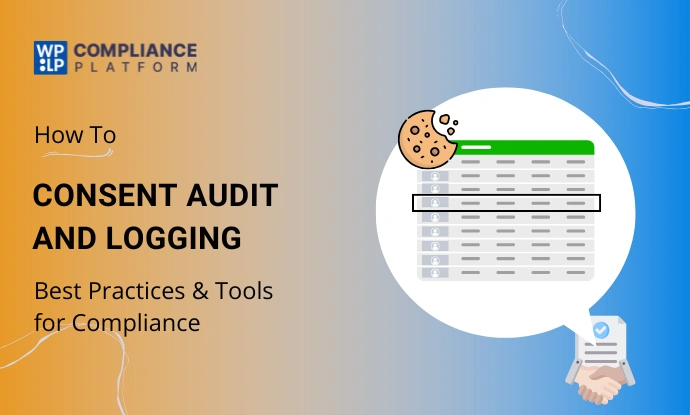
Summary
Best practices for consent logs are: securely store your logs, regularly audit logs, and create backups. Use automated solutions like WPLP that can make consent logging less of a hassle. Additionally, WPLP can help fulfill DSARs, provide geo-targeted banners, and policy pages.
Can your website provide undeniable evidence of consent in audits or DSARs?
Consent management is a serious legal and operational challenge in today’s privacy-focused digital landscape.
With fast-evolving regulations such as GDPR and CCPA, the expectations for websites to respect user privacy and demonstrate responsibility for doing so are higher than ever. Simply having “We use cookies” is no longer acceptable.
What you actually need is the capacity to demonstrate a clear, time-stamped record that shows what the user consented to, when they consented to it, and how this was done.
This guide will act as a comprehensive solution for auditing, consent logging, and compliance.
We’ll discuss the legal and business risks of not logging records, identify the specific points of data you should be capturing, and detail the best practices for security.
And most importantly, we’ll show you the tools that can automate this challenging process.
- Why Consent Logging Matters: Legal and Business Risks
- What is a Consent Audit? What Should You Be Logging?
- Best Practices For Consent Logging
- 1. Use an Automated CMP that Logs Consent Actions
- 2. Ensuring Integrity and Security of Consent Logs
- 3. Fully Logging Consent Changes
- 4. Backup and Test Log Retrieval Regularly
- 5. Schedule periodic consent audits
- 6. Comply with data minimization and retention rules
- 7. Account for Geo-Targeting and Multi-Lingual Consents
- Tools & Plugins: Automating Consent Audit and Logging
- How to Audit Your Consent Logs (DSAR and Regulator Audit Scenarios)
- Case Study on Sephora Case 2022
- FAQ
- Conclusion
Why Consent Logging Matters: Legal and Business Risks
Imagine a visitor to your WordPress site. They click “Accept” on your cookie banner, but your site does not log their consent. Months later, they filed a GDPR (General Data Protection Regulation) complaint saying they never gave permission. During the investigation, the data protection authority requests proof of consent.
As your site does not keep any logs, you cannot prove when or how the consent was provided. What happens next? Potential fines, loss of customer trust, and legal consequences from GDPR violations. This all can happen because you have no consent logs.
Consent logging is the practice of securely recording users’ consent choices regarding their data. This process is essential for proving that consent was obtained lawfully, not through false pretenses.
Without proper consent logging, you face significant legal and financial risks, including penalties and reputational damage, even in the absence of a data breach.
Laws like GDPR and CCPA are built on the principle of accountability, which means it is the responsibility of the data controller (i.e., your business) to prove that the user provided consent to them to process their data.
As Article 7 of the GDPR explicitly states,
“Where processing is based on consent, the controller shall be able to demonstrate that the data subject has consented to processing of his or her personal data.”
This means you are required to document that the consent was given freely, specifically, informed, and unambiguous. Additionally, you will need to show that it is as easy for users to withdraw consent as it was to provide it.
The California Consumer Privacy Act (CCPA) works on an “opt-out” framework that requires businesses to keep reasonably detailed records.
If a consumer chooses to exercise their “Right to Know” (which is essentially a Data Subject Access Request or DSAR), you must be able to provide a complete account of your data collection, including where you obtained consent for or any personal information you processed.
In several situations, Consent logs stand out as the first and most crucial line of defense:
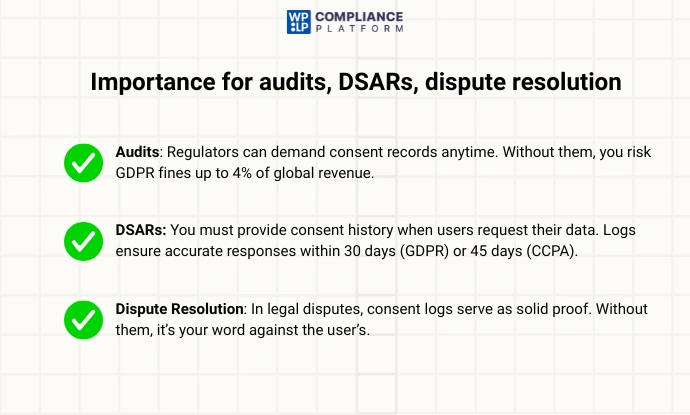
Compliance Proof Cookies and Regulator Expectations
Regulators don’t just want to see a cookie banner. They want to see the verifiable backend data associated with it. This is where “compliance proof cookies” come in.
It is the consent management tools that track user consent actions such as opt-ins, preferences, time-stamps, and IP addresses, and store them securely. Regulators expect these logs to be tamper-proof, accessible, and time-stamped, ensuring traceability of consent.
Without them, proving lawful data collection during regulatory reviews or user complaints becomes extremely difficult.
What is a Consent Audit? What Should You Be Logging?
A Consent Audit is the process of reviewing, verifying, and documenting how your organization collects, manages, stores, and tracks user consent related to data processing.
Moreover, the audit examines whether the methods of collecting consent are legally compliant. Includes checking consent is given freely (no pre–checked box), specific (for a purpose), informed (the user knows what they are consenting to), and unambiguous (requires a clear and affirmative action, such as a click to accept the consent).
So, if you want to be audit-ready, your consent should include.
- Time-stamp – When the consent was given
- User or Device ID – Who gave the consent (if identifiable)
- Action Taken – Whether the user accepted, declined, or modified consent
- Consent Text/Version – The exact policy or terms the user agreed to at the time
- Geolocation (if relevant) – Location data to help determine applicable laws (e.g., GDPR vs. CCPA)
Basic Logs vs. Compliance-Ready Evidence
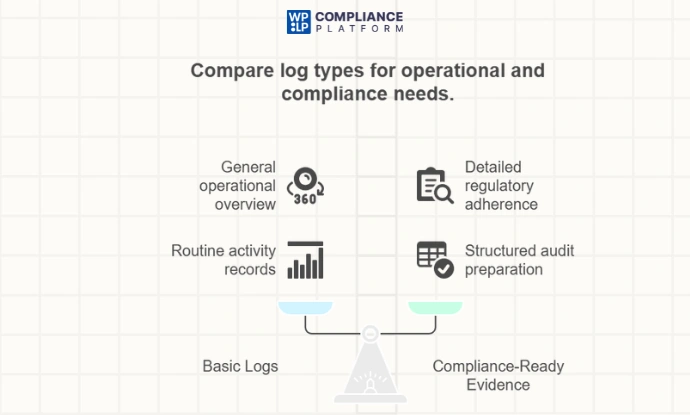
A Basic log entry states that a user accepted your cookie policy, but that’s not sufficient for a formal audit, and it doesn’t contain the level of detail needed to show compliance.
Compliance-ready evidence is an authoritative record that is detailed and tamper-evident. It contains all present “must-have” items described above. It allows you to satisfy regulator inquiries by providing a complete, auditable trail when authorities request proof of consent.
Compliance-Ready Evidence also helps fulfill Data Subject Access Requests (DSARs) by enabling you to give users an accurate account of what data was collected and how.
In times of legal dispute, these logs act as valid evidence, showing not only that the user consented, but also that your data processing activity was lawful.
Best Practices For Consent Logging
Establishing a consent logging system that is reliable, robust, and durable is a critical part of data protection. There are a few ways in which you can ensure your consent logs are compliant, ready or not.

1. Use an Automated CMP that Logs Consent Actions
Choose a CMP that automatically records all user consent actions, including acceptances, rejections, and changes.
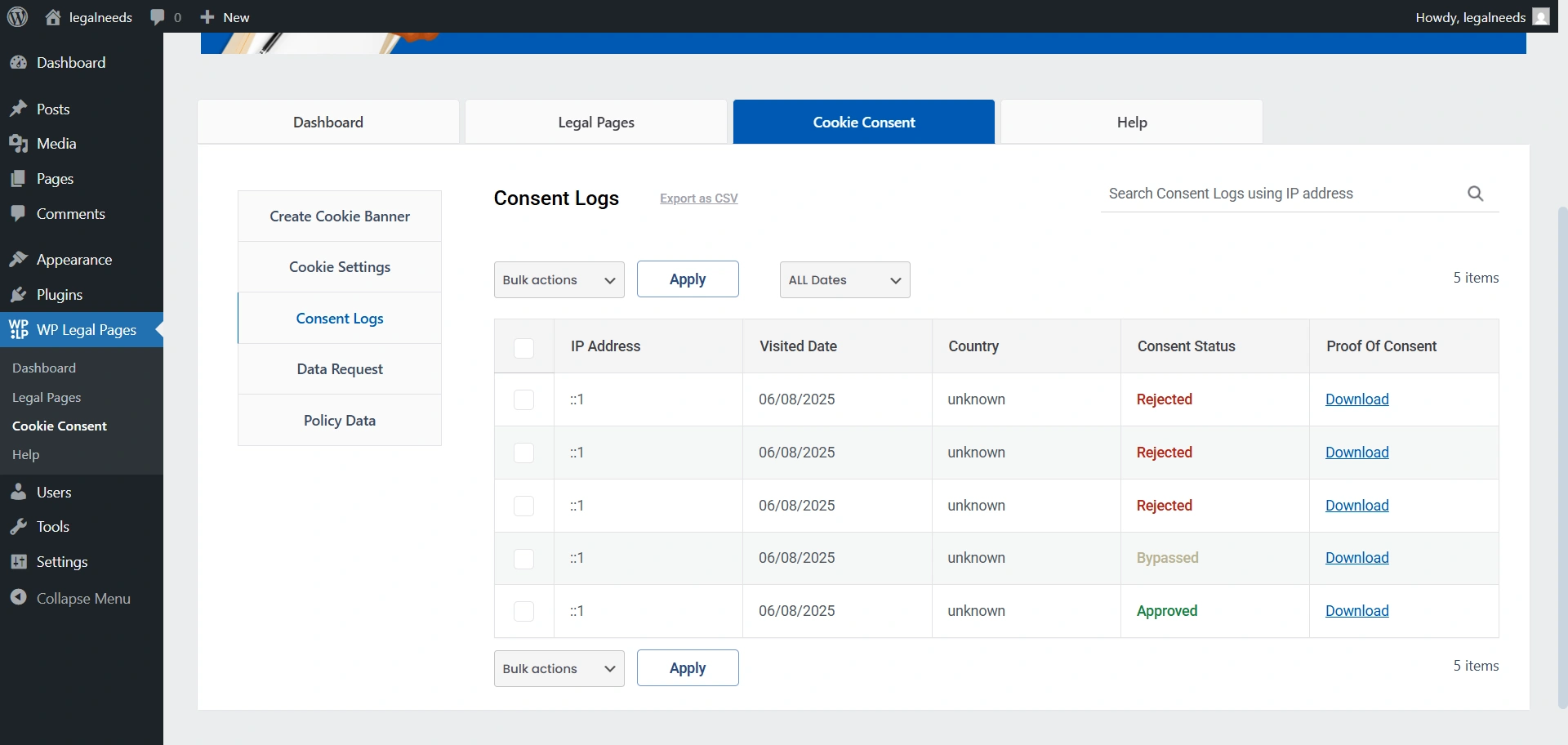
Like the WPLP Compliance Platform, it records automatically and stores a detailed log of every user’s consent interaction. This includes the crucial data points like the date, browsing type, and the user’s IP Address.
2. Ensuring Integrity and Security of Consent Logs
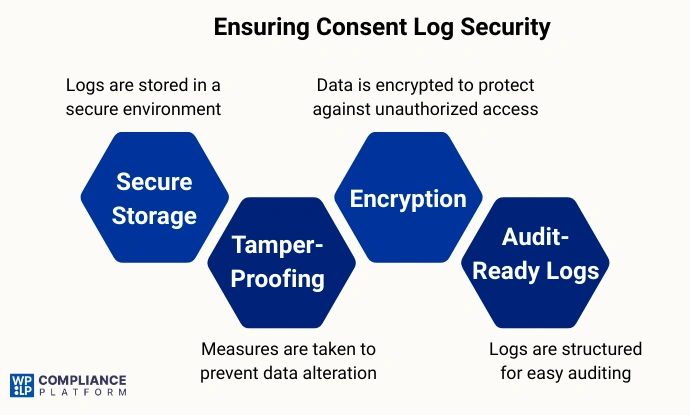
One of the most critical tasks is to store consent logs in a secure, encrypted environment. Please make sure they are tamper-proof to maintain data integrity and legal validity. WPLP’s cookie consent management log stores these audit-ready logs within the WordPress environment, but in a structured and safe manner.
3. Fully Logging Consent Changes
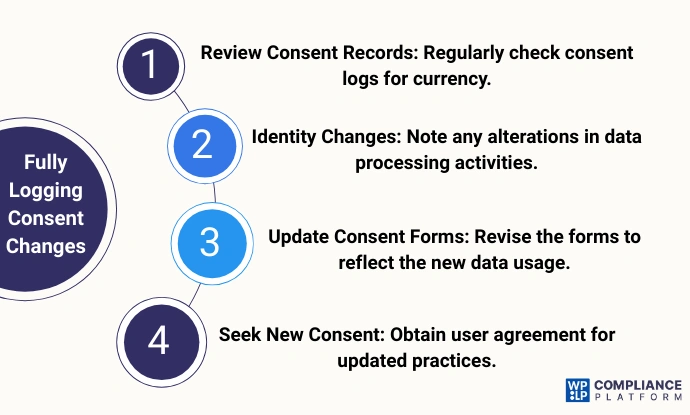
Consent is never a one-time event. It is essential to review the cookie consent records on a regular basis to ensure consent is current and relevant and has not changed.
It is best practice to review the contract on a regular basis, especially when any significant changes take place in relation to the data processing activity.
For example, an educational tech company may look to annually review existing cookie consent records, and seek new consent from users if there are changes in how data is used, maintaining both compliance and data transparency can be hard.
4. Backup and Test Log Retrieval Regularly
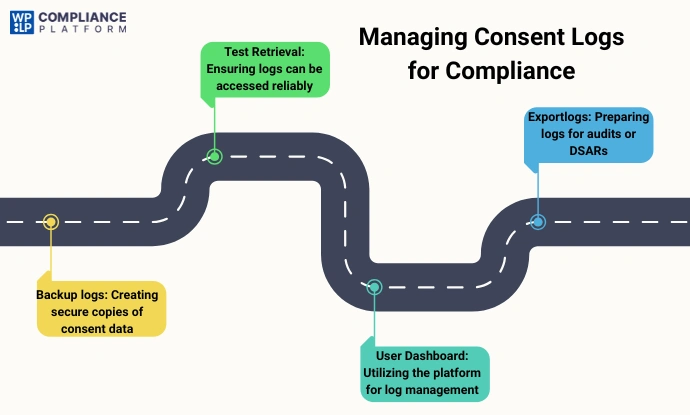
Ensure you have backup copies of your logs, and verify that retrieval processes are well tested so you can access them during audits or DSARs.
For that, you can use the WPLP Compliance Platform, a cookie consent manager that comes with a dashboard that has an intuitive and easy-to-use interface showing consent logs. It also offers a consent log export feature, allowing you to easily download and store records for audits, compliance reviews, or legal documentation.
Wherever necessary, you can export these logs for a consent audit or for responding to a Data Subject Access Request (DSAR).
5. Schedule periodic consent audits
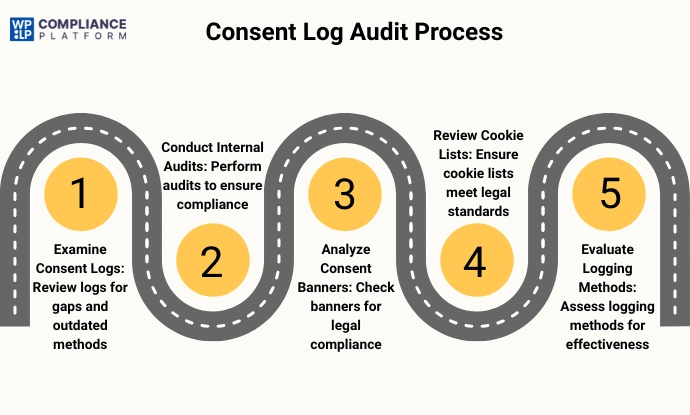
Regularly examine your consent logs and procedures to identify gaps, outdated methods, or compliance issues. Conduct internal audits at least once every year. Analyze consent banners, cookie lists, and logging methods to ensure compliance with applicable laws.
You should also run regular cookie scans. If you can do it manually, you can use the WPLP Compliance platform to run a scan automatically for you. It will detect and document any new or changed cookies on your site, ensuring ongoing compliance.
6. Comply with data minimization and retention rules
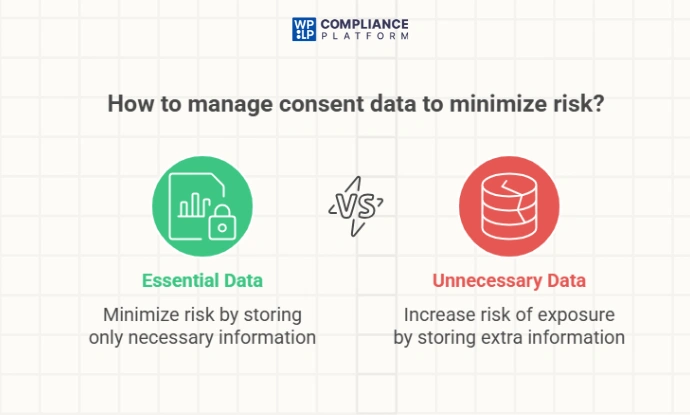
Only document and log the consent that is strictly needed. Do not store data that is not required and is unnecessary. This will increase the risk of exposure. For example, avoid logging personally identifiable information (PII) beyond what’s needed.
7. Account for Geo-Targeting and Multi-Lingual Consents
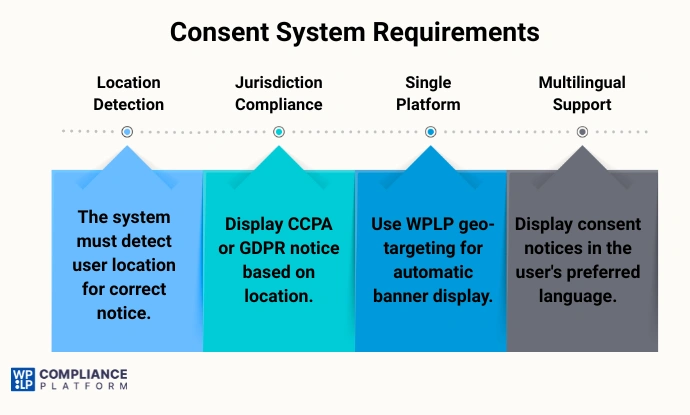
Your consent system must be able to detect a user’s location and display the correct consent notice for their jurisdiction. A user in California needs to see a CCPA-compliant notice, while a user in Germany needs a GDPR-compliant one.
If you want to operate this form on a single platform, you can also use the WPLP Geo-targetting feature. This functionality allows it to detect a user’s location and automatically display the correct, legally-mandated consent banner.
Moreover, it also supports multi-lingual capabilities, ensuring that consent notices are displayed in the user’s preferred language.
Tools & Plugins: Automating Consent Audit and Logging
Manually auditing and logging user consent is not only time-consuming, but it also leaves room for human error, making businesses vulnerable to non-compliance risks.
The best way to manage this is through IAB-certified Consent Management Platforms (CMPs) (this adds more trust and authority) or even some specific WordPress plugins. They automate the process of creating and documenting user consent while providing data security, transparency, and legal compliance.
Popular CMPs at a Glance
Several popular tools simplify compliance by offering automated consent logging and audit-ready reports such as
CookieYes
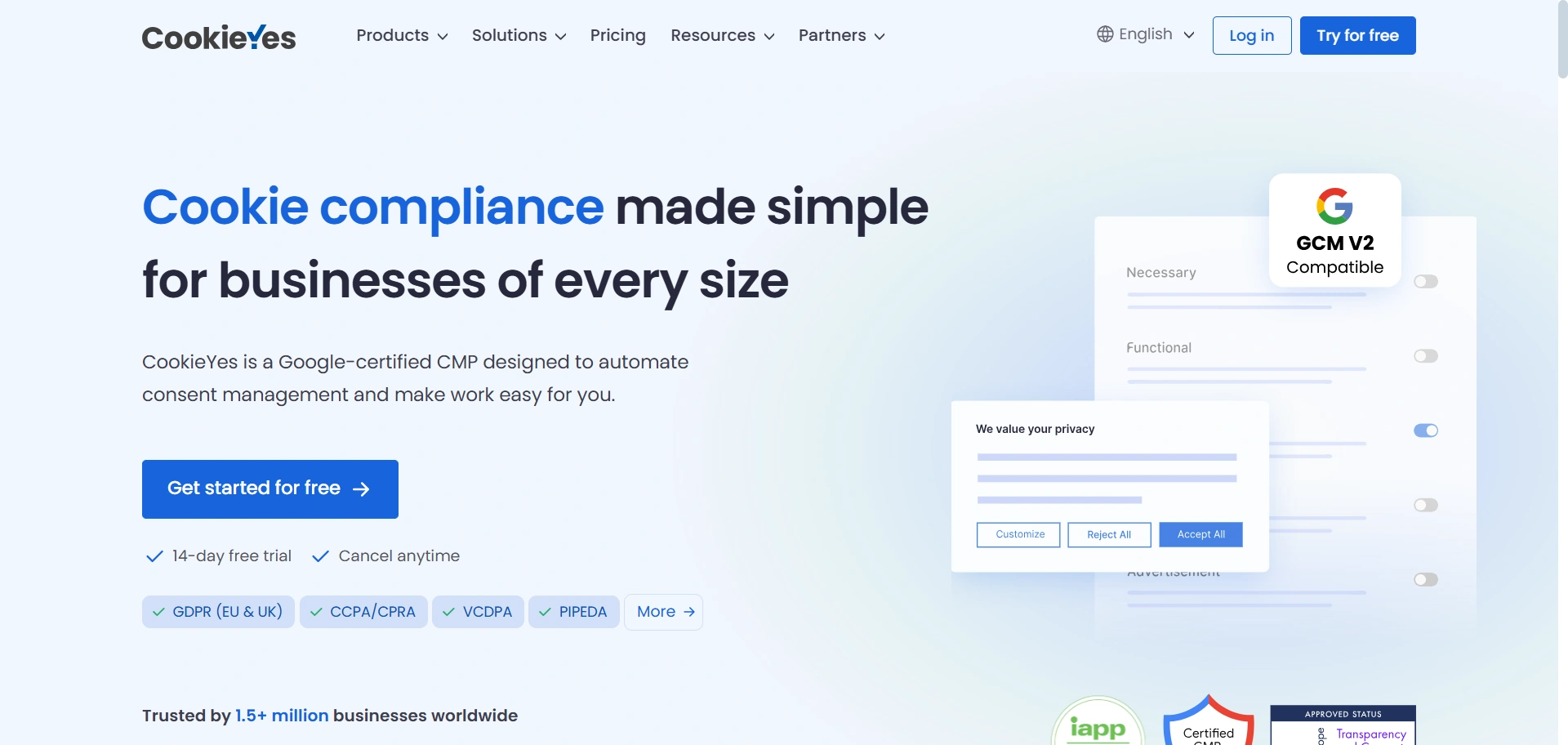
- Offers cookie consent banners, automatic cookie scanning, and geo-targeting.
- Most of the features are locked behind the premium version, and sorting options are limited. Unlike WPLP, which offers convenient filters like month-wise sorting, this tool lacks a proper solution for easy log management.
Complianz
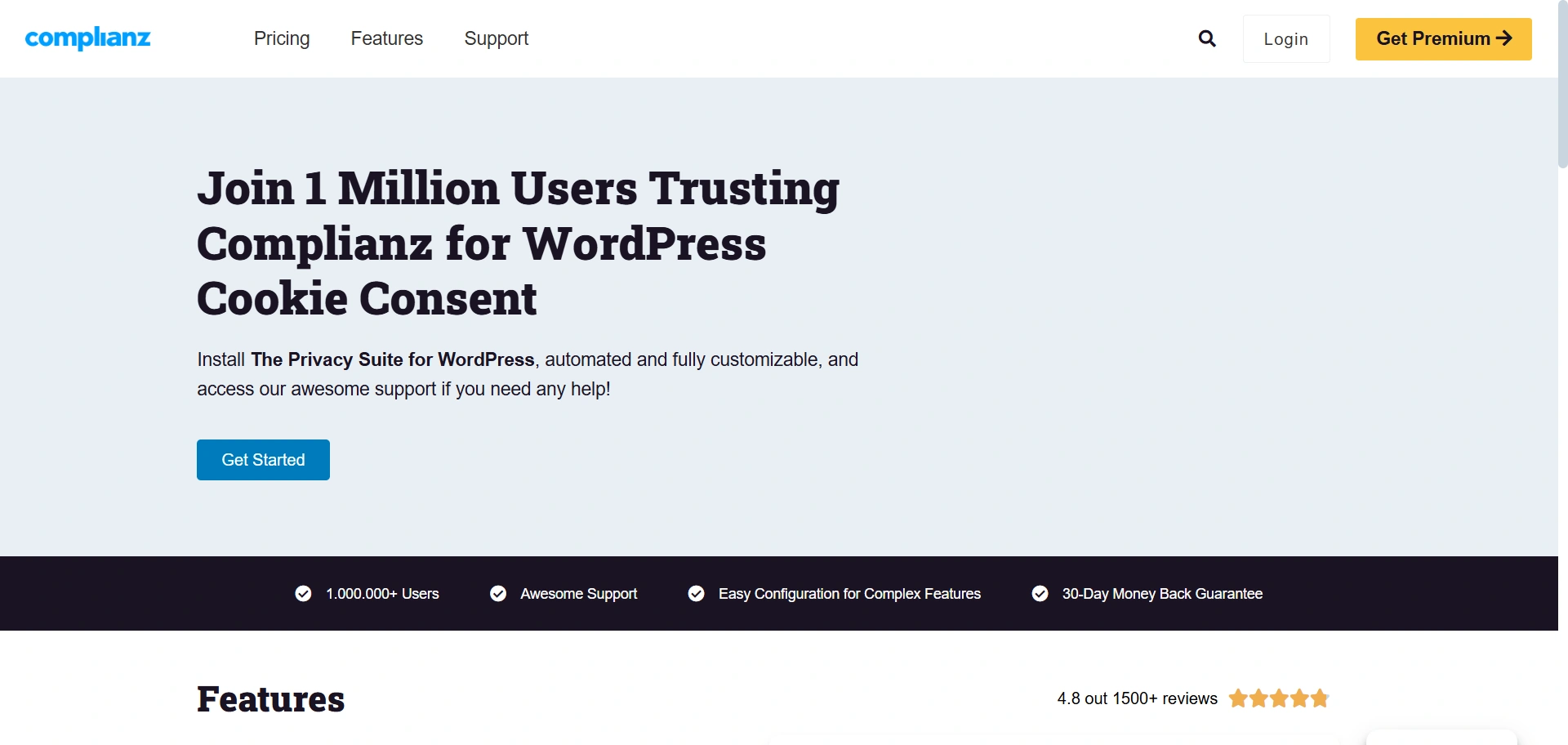
- A comprehensive plugin with strong integration for WordPress. But overwhelming for beginners.
- Offers region-specific compliance, consent records, and A/B testing.
- Logging features are available but may require setup.
Termly
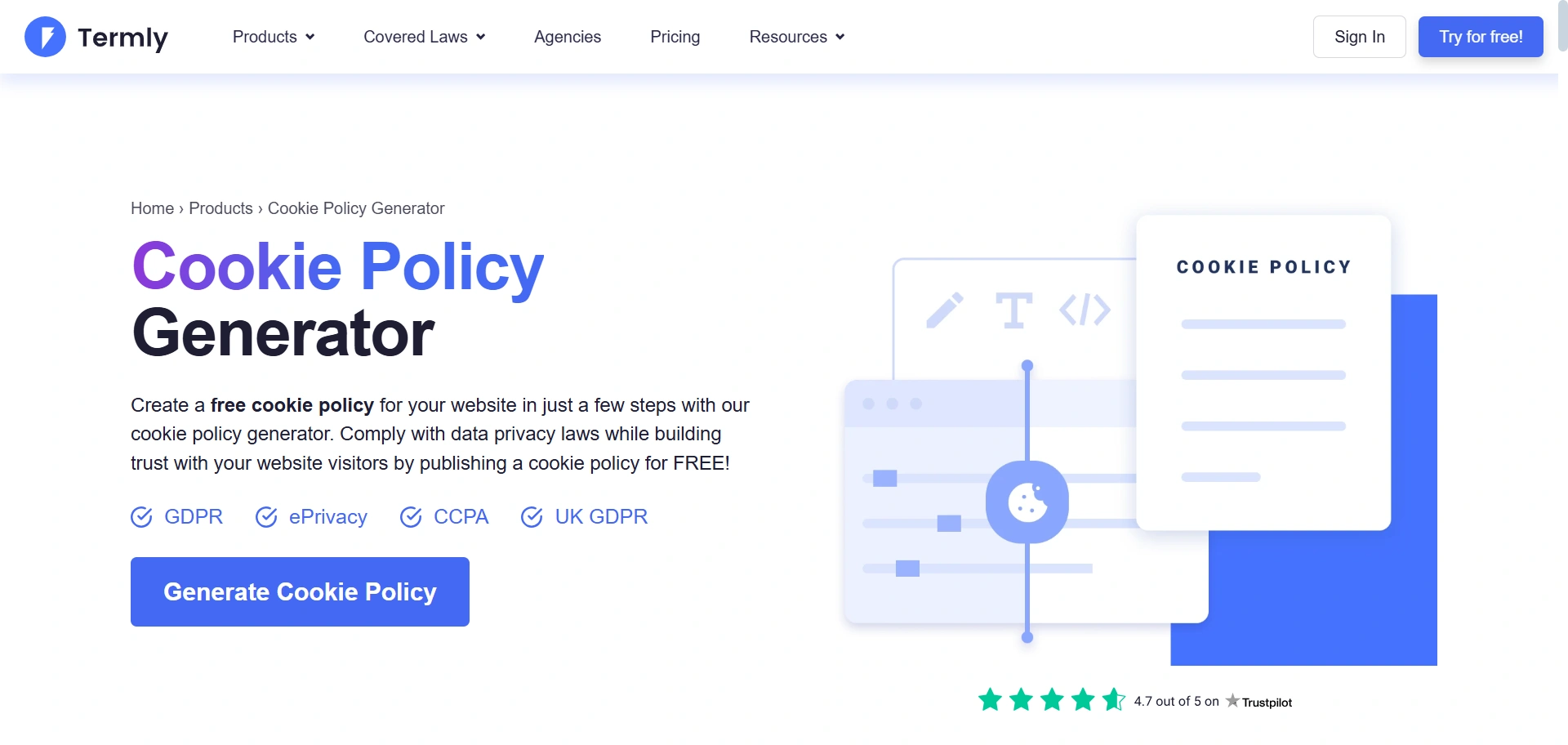
- Provides a cloud-based solution for consent, privacy policy, and cookie management.
- Comes with a consent log dashboard, but lacks flexibility. It is not easy to operate it from the dashboard.
WPLP Compliance Platform
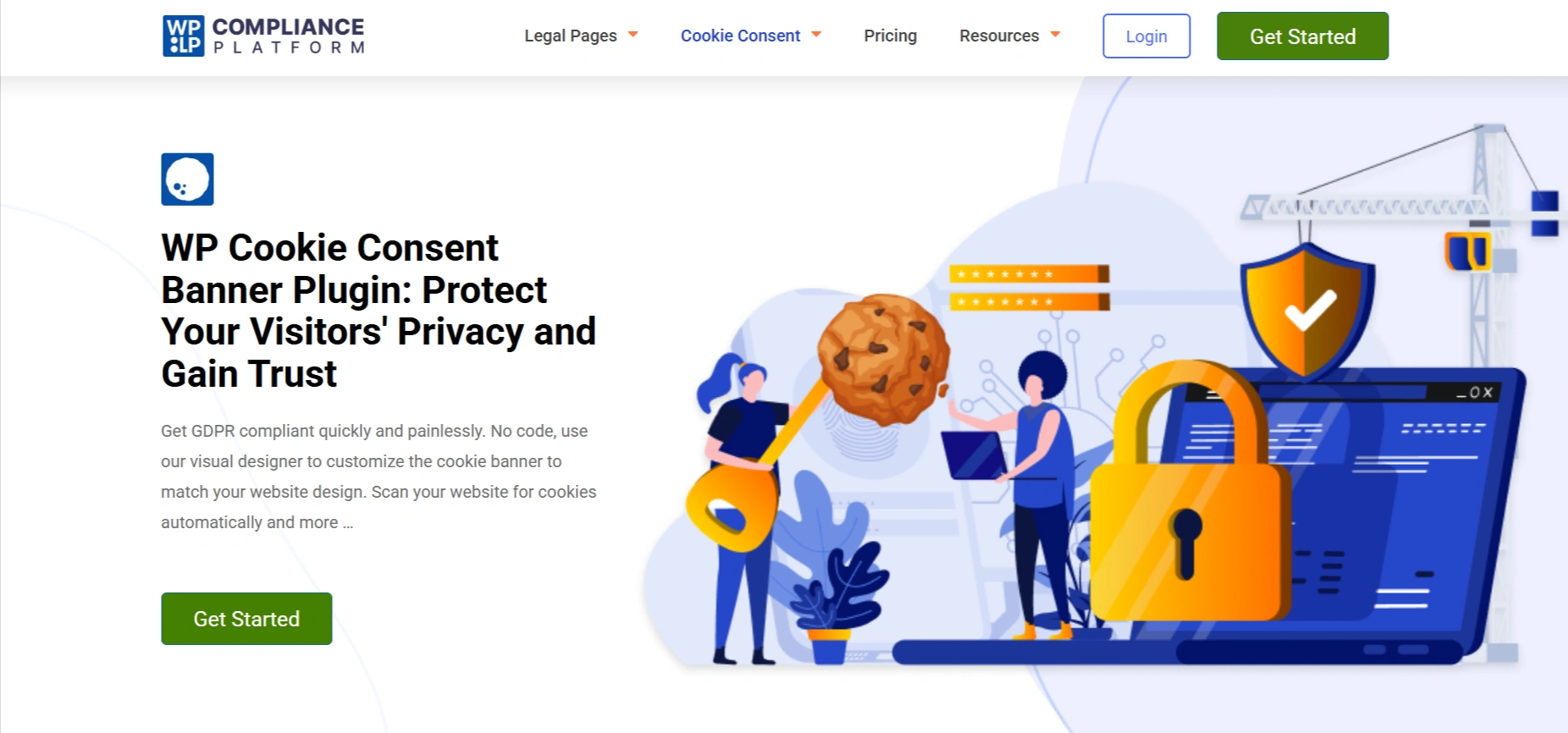
- With the cookie consent manager, every consent action is automatically logged on the platform with a time-stamped record of the consent action, the user ID, and the exact version of the policy at the time of consent.
- An essential aspect of the WPLP platform is built-in DSAR capabilities. The platform allows users to easily request what an organization has on them, in a compliant way, therefore allowing you to meet these legal obligations in a timely and efficient manner.
- If you’re a global organization, we encourage you to use the WPLP platform. The platform’s broad capabilities allow you to automatically detect a user’s geographic location and present the appropriate consent banner and legal policies according to local laws (i.e., GDPR compliant banner for an EU user, CCPA-compliant banner for a California user). You can also choose to present in multiple languages to ensure the consent notice and policies are “clear and plain” regardless of the user’s language.
- WPLP’s core offering extends to an extensive library of professional privacy policy pages so that you can generate and manage all your legal pages in one place.
How to Audit Your Consent Logs (DSAR and Regulator Audit Scenarios)
Maintaining the consent log is not your only job. You need to audit the consent log also. In order to have control over data management, you need to be able to audit your consent log.
This is an important step, especially when there are data subjects’ access requests and regulatory audits.
Manage log consent by:
- Identify the User: You can sort the users in some specific ways, like from their user ID, email, or through their recorded consent.
- Search and filter: Use your consent management platform (CMP) or database to get all logs for that user, applying any filters based on the date range and event type (accepted, rejected, updated).
- Export Logs: After filtering the logs, export the results as a file (CSV or PDF) as a clear, documented record.
- Review and Verify: Ensure that the exported result is complete, and includes details, including time-stamps and specific consent choices. This is your proof of compliance.
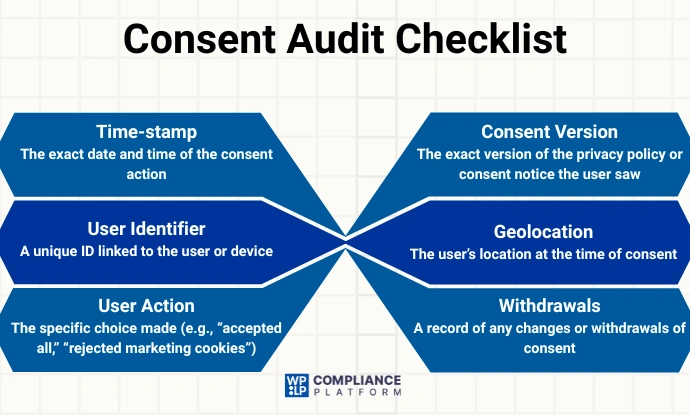
Here are a few mistakes that you should avoid while doing an audit.

- Missing Withdrawals: Only logging initial consent is a serious mistake. You have to log when the user opts out of consent, so you have evidence that you acted on the request.
- No Version Control: If you update your privacy policy but don’t log which version the user saw, you won’t be able to prove the consent was appropriately informed.
- Lack of Granularity: Logging “accepted cookies” only is insufficient. Regulators require evidence of informed consent for different purposes of data processing (e.g., analytics vs. marketing).
- Failure to Act: Logging an opt-out is just the start. You have to ensure that you transmit the opt-out signal to all third-party systems immediately to stop all data processing.
- Insecure Logs: Storing logs in an unsecured or easily editable format (like a simple spreadsheet) can compromise their validity in an audit.
Case Study on Sephora Case 2022
The 2022 Sephora case clearly exemplifies the penalties that you have to face if you do not follow the law. It marked its first public enforcement action under the California Consumer Privacy Act (CCPA), led by the California Attorney General.
According to the Attorney General, Sephora violated the CCPA in three key ways:

After all the conflict, the case was finally solved in August 2022, and Sephora agreed to settle by paying $1.2 million fine, update its privacy policy to disclose data sales, Honor GPC signals, and improve opt-out mechanisms. Implement a CCPA compliance program with ongoing monitoring, and revise contracts with service providers to limit third-party data use.
FAQ
Consent logging is the process of maintaining a secure record of a user’s consent decisions. It’s more than just asking for permission. It’s about demonstrating that you have obtained valid consent, which is a key aspect of many data privacy laws.
There is no universal answer, since retention periods are often not explicitly stated in many regulations. The general rule is to retain records of consent for as long as you are processing the relevant personal data and for a reasonable time afterwards to evidence compliance when there is a challenge.
Consent Management Platform plugin automatically creates the consent banner and includes the technical features of logging, auditing your site for cookies, and categorizing all your cookies. You need to ensure the consent banner is designed for your audience. It also represents a single, secure, centralized log of all user consent decisions. You can also search, filter, and export records when you need to.
The data consent log should contain a time-stamp, the user’s IP address, the action performed by the user on the cookie, and geolocation if relevant.
Yes, consent logs are accepted internationally, but their validity depends on meeting the legal requirements of the specific privacy law or jurisdiction involved.
Opt-in consent means the user must clearly say “yes” before their data can be used. This is the preferred method under strict laws like the GDPR.
Opt-out consent means the user is considered to have agreed unless they take action to say “no”.
Conclusion
Consent logging is essential for legal compliance and trust. Whenever a user interacts with your website and either accepts or denies consent, it is essential to log that decision securely. These logs can serve as evidence that consent has been properly collected and, in the event of a legal dispute or complaint, can safeguard your business.
For example, if a customer claims their consent was taken unconsentingly, thorough consent logs can show exactly when consent was taken, how consent was taken, and what the consent was for.
However, it is equally important to audit consent logs. Ensure the logs are securely stored and well-organized so that, if a user submits a DSAR (Data Subject Access Request), you can supply complete, clear, and accurate documentation without delay.
The WPLP Compliance Platform solves your need for easy and effective automation for consent logging.
It provides advanced features for managing consent, generating legal documents, and handling data subject access requests. You can explore the platform’s features and simplify your compliance by trying the platform, booking a demo, or reaching out to the support team with any questions.
Disclaimer: This blog is for informational purposes only and not legal advice. Privacy laws vary and may change. Consult a legal expert for full compliance. While we mention tools such as the WPLP Compliance Platform, it is made in good faith.
If you like this article, consider reading:
- How to Add Cookie Consent Banner in WordPress From Scratch
- How to Add a GDPR-Compliant Cookie Policy To Your Website
- Best Cookie Policy Generators to Keep Your Website Compliant
Want Cookie Banners for WordPress Websites? Grab WPLP Compliance Platform now.
